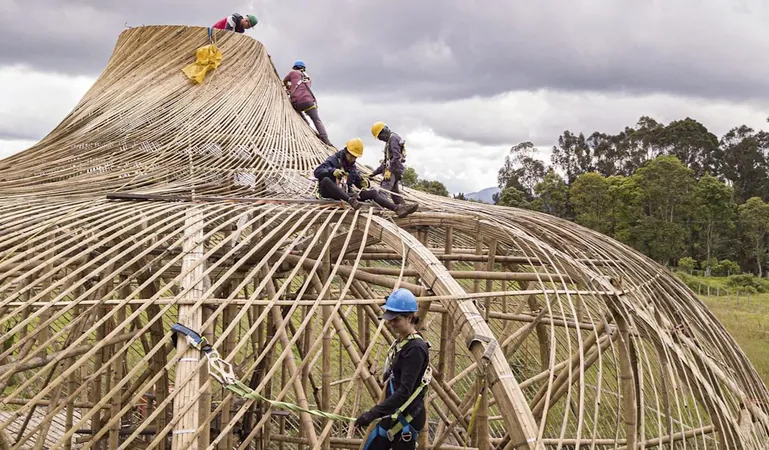
Revolutionizing Architecture: How One Former Architect Is Redefining Sustainability in Colombia
2025-05-06
Author: Mei
From Corporate Architect to Eco-Innovator
In the quest for a better tomorrow, sometimes we need to acknowledge the lessons of the past. This idea is flourishing just outside Tenjo, Colombia, where an Indigenous construction lab is transforming our understanding of "sustainable architecture."
Welcome to the Centro de Regeneración
The Centro de Regeneración spans 30 acres of open-air space, merging age-old building techniques with modern ecological insights. The site is an artistic blend of experimental structures that resemble coiled pots, woven baskets, and even doughnuts, operating as living workshops for earth construction, ecological restoration, biodynamic agriculture, and the healing properties of native flora.
Meet Ana María Gutiérrez: The Visionary Behind the Movement
The inspiration behind this groundbreaking center is Ana María Gutiérrez, a former architect from New York who left the corporate world after a life-changing experience with rammed earth in Colombia. "The moment I was barefoot, working with the earth, I realized, 'What am I doing sedentary at a desk every single day?'" Gutiérrez's revelation sparked a transformation of the land into a dynamic laboratory where learning occurs through sensory interactions.
Unlearning Colonial Notions of Progress
Gutiérrez's mission is to challenge the colonialist notions of progress that have deep roots in our society. "People discuss sustainability, but what exactly are we sustaining?" she questions. This philosophy is the foundation of her nonprofit, Fundación Organizmo, which aids Indigenous communities in preserving their ancestral building wisdom.
A Broader Impact: Connecting Communities and Cultures
Organizmo's reach extends beyond Tenjo. Collaborating with the Re:Arc Institute, backed by the Inter Ikea Foundation, Gutiérrez's organization is revitalizing traditional crafts at risk of disappearance, such as palm-weaving in the Piaroa de la Urbana community. By working with elders, they co-designed classrooms and curricula to secure this invaluable intergenerational knowledge.
Empowering Indigenous Voices
In a significant move, Organizmo is also uplifting young filmmakers from eight Indigenous groups in the Amazonian region of Vaupés, to document both land exploitation and cultural resilience. Their message is clear: Indigenous leadership should focus on protection, not extraction.
A Community-Centric Approach to Sustainability
These low-tech, high-impact solutions are part of a larger movement funded by Re:Arc that promotes community-centric wisdom over corporate practices. For example, Oasis Urbano is a design collective reviving neglected neighborhoods in Medellín, like Moravia, with similar philosophies.
Grounded Solutions for a Healthier Future
In a world flooded with high-tech materials like bioceramics and hempcrete, Organizmo's down-to-earth approach is a breath of fresh air, literally and figuratively. By prioritizing community connections, air quality, and eco-friendly living, Gutiérrez is paving the way for homes that are both sustainable and culturally enriching.
Rethinking Ancestral Knowledge
As Gutiérrez poignantly asks, "What if we viewed ancestral knowledge not as a relic of the past but as a vibrant, guiding force for building resilience today?" This holistic understanding could very well be the blueprint for a sustainable future.


 Brasil (PT)
Brasil (PT)
 Canada (EN)
Canada (EN)
 Chile (ES)
Chile (ES)
 Česko (CS)
Česko (CS)
 대한민국 (KO)
대한민국 (KO)
 España (ES)
España (ES)
 France (FR)
France (FR)
 Hong Kong (EN)
Hong Kong (EN)
 Italia (IT)
Italia (IT)
 日本 (JA)
日本 (JA)
 Magyarország (HU)
Magyarország (HU)
 Norge (NO)
Norge (NO)
 Polska (PL)
Polska (PL)
 Schweiz (DE)
Schweiz (DE)
 Singapore (EN)
Singapore (EN)
 Sverige (SV)
Sverige (SV)
 Suomi (FI)
Suomi (FI)
 Türkiye (TR)
Türkiye (TR)
 الإمارات العربية المتحدة (AR)
الإمارات العربية المتحدة (AR)